Patterning your shotgun at a known range with the load and choke constriction you intend to use in the field is important to your success in wingshooting, but is especially critical when it comes to turkey hunting. Smaller, tighter patterns are best for turkey hunting, as you aim the shotgun and fire at a stationary target much as you would with a rifle. Some type of sighting system is helpful to ensure that your loads are printing roughly to point of aim, and you will need a bench or a steady rest.
I recently patterned my 12 gauge 870 with three different turkey loads in preparation for an opening day trip to Tennessee. Note the fiber optic open sights and my homemade tomato stake shooting sticks. I have shot full-house turkey loads off a bench rest before, and I don’t intend to repeat the experience.
Here is the target, an 8 inch circle at 40 yards. I chose 40 yards because that is about the maximum distance at which I would consider taking a shot at a gobbler. That circle looks awfully small, doesn’t it?
In fact, the dot of the front sight subtends the entire circle at that range. I don’t believe one needs a lot of precision in aiming for turkeys, just a point of reference, but it would be important in using this setup on a bird to aim for the wattles rather than the head. One could easily shoot over the bird entirely if aiming at the head completely obscured by the dot.
The first load I tested was a Federal Premium Turkey Load in 3″ magnum with 2 ounces of copper plated #4 shot. I chose the #4 shot for the increased knockdown power, although by some accounts, #4s do not pattern as well as the smaller shot sizes. I was using a Lohman Long Shot extended turkey choke, and I thought the result was satisfactory.
The next load was a PMC 3″ magnum stoked with 2 ounces of buffered, nickel plated #4s, and the first pattern suffered by comparison.
I really liked the way this load put several pellets right down the pipe clicca qui. The splattered orange stuff is just cool. There are more holes around the periphery in this picture, but I was using the same backing board for each shot.
The final load I considered was an old 3″ Remington Duplex loaded with 1 7/8 ounces of #4 and #6. This one looks awesome in spite of the slightly reduced payload, but remember that some of those holes are from the #6 shot.
A rough count revealed 66 pellets in the black for the Federal load, 76 for the PMC, and a whopping 99 for the Remington. I pronounced the gun and choke combination a turkey killer with either of the three loads, but I opted for the PMC owing to the roundness of the pattern and the heavier hitting #4s.

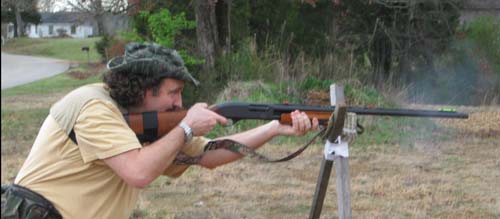

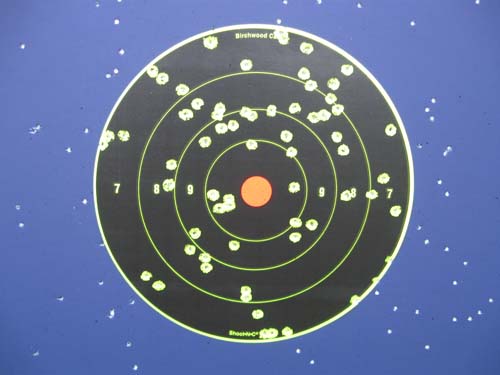
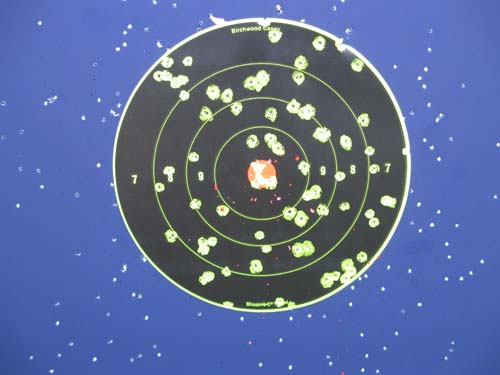
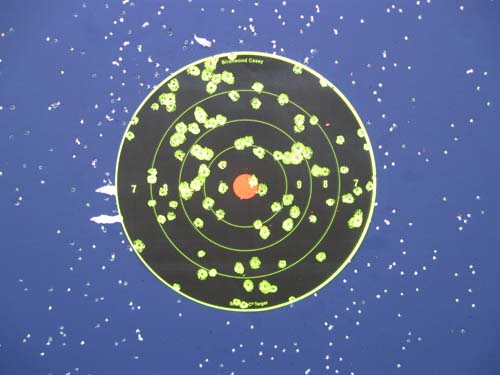
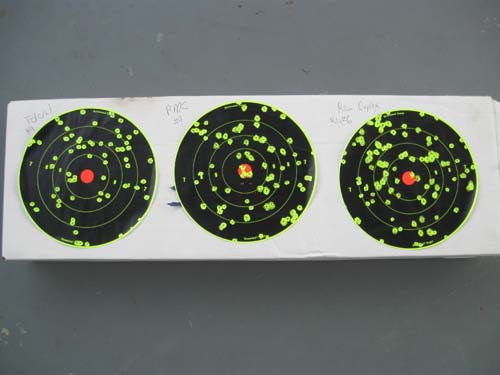
4 responses so far ↓
1 ellenbr // Apr 12, 2009 at 6:57 am
Interesting patterns Armchair. Did you happen to get a count on the total number of shot before firing in order to determine the choke? 40 yards meets the criteria for determining choke; at least for the Gun Trials of the 1870s, 1880s, etc. and for the Brits. Chokes are sold as IC, IM, M, F, etc. but really the only way to determine the choke is to test fire the longarm and get a ratio of the number of pellets in a 30 inch circle at 40 yards. This percent is the actual choke and determining that value is effort and time consuming. Regarding the semi-auto smoke-poles, an alignment delta of +/- 4″ (could be more or less as this is from memory) is acceptable with respect to the line of sight. So even if you have the sights aligned, the pattern may be centered to one side or the other. But true most of the time the desginated chokes are close but if you are going to consistently shoot at certain ranges, then definitely your longarm needs to be patterned with the intended shot size. Also different size shot patterns differently and if a tube is choke bored for #4 (American or British) shot, then it will pattern #4s well. There’s a lot of hype about the longer cartridges say 3″ and 3 1/2″ but for the most part one is burning more powder and experiencing more recoil. Baby Mags (Kent’s Ultimate Upland) and Polywad’s Polymag cartridges at a length of 70mm are a force to be reckoned with. Then again in the “Golden Era of Shotgunning” the Brits, and others, were doing as well or better with 65mm cartridges.
Kind Regards,
Raimey
rse
2 ellenbr // Apr 12, 2009 at 7:29 am
I failed to mention in sticking with the strict definition of patterning, first shoot the pattern and then draw the circle of 30″ oriented at the center of the max. distribution of pellets.
Kind Regards,
Raimey
rse
3 armchairoutfitter // Apr 12, 2009 at 9:46 am
Raimey, you are, as usual, correct. What I did was kind of a hybrid patterning and sighting in, because I already had the shotgun and screw-in choke I would be using on that trip. I needed a comparison of the the three shells I had on hand to see which one would perform as needed with that combination. Years ago, there were so few load options available to those of us living in the hinterlands that I didn’t see much use in patterning in the true sense of the term. What you could get was what you got, and you hoped for the best. Getting back into shotshell reloading has renewed my interest in the pattern board. I am particularly keen to do some pattern testing with the 20 gauge, the “20 bore” to Anglophiles, as it is notoriously finicky in this regard. All other things being equal, a 1 oz load from a 12 is usually better than the same charge of shot from a 20. I’d like to test this theory over the summer. If you are doing some patterning of your own in preparation for the Vintagers shoot, maybe we could have the first ever shotgun only Big Shoot.
4 ellenbr // Apr 12, 2009 at 6:34 pm
A smaller bore/tube will result in more dispersion, fliers, wider pattern and an elongated shotstring. Don’t forget the pattern is 3D and what you see on a pattern board is compressed in time. If your shotstring is long, the target may not be there when the pellet density arrives or the pellet density is time dependent. But then again the quarry is turkey and possibly stationary, but I’d much rather shoot them on the wing than walking. I’ve seen the #4/#6 Duplex seemingly just bounce off on walking Toms. Basically it all boils down to empirical data and I think it was W.W. Greener who determined that regarding pigeons, 3 shot in a vital area were required to neutralize. As you know I don’t cotton to a 20 bore but I will admit I’ve seen 10′s of thousands of doves downed with a 20 bore south of the equator. You may need to get yourself a proper gun and load for each respective quarry. But another note on choke, which I am guessing was in the 1950s (it could have been earlier), is that instead of full, mod, IC, etc. terms like “points of constriction” or “points” started to be used. And all it means is that the tube at the muzzle is “X” number of points smaller in diameter. Last, shot diameter varies from country to country. So if you are using nickel plated shot from Italy, it may or may not be the same diameter as American shot with the same number designation.
Kind Regards,
Raimey
rse
Leave a Comment